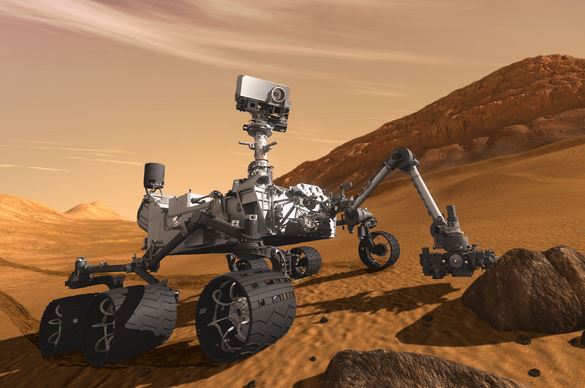The Curiosity robot’s tunable laser spectrometer in the SAM (Sample Analysis at Mars) has unequivocally detected an episodic spike in methane concentrations in the Red Planet’s atmosphere after a comprehensive analysis of data following 605 Martian days (605 soles). Does this mean there could be life on Mars?
Scientists from the Mars Science Laboratory (MSL) wrote about the finding in the academic journal Science (citation below). Co-author, Francisco Javier Martín-Torres, works at the Andalusian Institute of Earth Sciences (Consejo Superior de Investigaciones Científicas y la Universidad de Granada, CSIC-UGR) in Spain.
Mr. Martín-Torres said the confirmation concludes a decade-long controversy regarding the presence of methane in Mars, after it was first detected with telescopes from Earth, initially by the Mauna Kea Canada-France-Hawaii Observatory.

The scientists analyzed 2 Earth-years’-worth of data from the Mars Curiosity robot’s instruments. (Image: Wikipedia)
The debate intensified later as measurements from orbiting satellites conflicted.
Where does the methane come from?
Now that there is no doubt, Mr. Martín-Torres says new research needs to look into what the sources of these fluctuating levels of the gas might be, which could include some kind of biological activity – life!
Nearly all methane on Earth comes from biological activity. The latest finding has dramatically increased expectations that the Martian methane could also be of similar origin. In other words, more bets are now on some kind of life existing in Mars.
According to previous scientific simulations, if Mars did have methane, it would linger for about 300 years, and during this period it would be evenly spread out across the atmosphere. So why did the Curiosity robot detect a spike in concentrations?

Francisco Javier Martín-Torres works at CSIC-UGR in Spain. (Image: Diario de Burgos)
Since there are no models that can account for Methane’s generation, localization and rapid disappearance, the authors decided to bypass that approach and analyze data from the Sam instrument, Mr. Martín-Torres explained.
By means of its tunable laser spectrometer, SAM has been detecting methane basal concentrations of about 0.7 parts per billion by volume (ppbv), and has confirmed an episodic spike of up to ten times this value during a period of six Martian days.
The authors wrote in an Abstract in Science:
“In four sequential measurements spanning a 60-sol period (where 1 sol is a martian day), we observed elevated levels of methane of 7.2 ± 2.1 ppbv (95% CI), implying that Mars is episodically producing methane from an additional unknown source.”
The new data are based on observations carried out in Mars over a 1-Martian-year period (two Earth years). During this time, Curiosity surveyed about 8 kilometers (4.971 miles) in the basin of the Gale crater.
Citation: “Mars methane detection and variability at Gale crater,” Christopher R. Webster, Paul R. Mahaffy, Sushil K. Atreya, Gregory J. Flesch, Michael A. Mischna, Pierre-Yves Meslin, Kenneth A. Farley, Pamela G. Conrad, Lance E. Christensen, Alexander A. Pavlov, Javier Martín-Torres, María-Paz Zorzano, Timothy H. McConnochie, Tobias Owen, Jennifer L. Eigenbrode, Daniel P. Glavin, Andrew Steele, Charles A. Malespin, P. Douglas Archer Jr., Brad Sutter, Patrice Coll, Caroline Freissinet, Christopher P. McKay, John E. Moores, Susanne P. Schwenzer, John C. Bridges, Rafael Navarro-Gonzalez, Ralf Gellert, Mark T. Lemmon, and the MSL Science Team. Science. 23 January, 2015. Published online 16 December 2014. DOI:10.1126/science.1261713.

